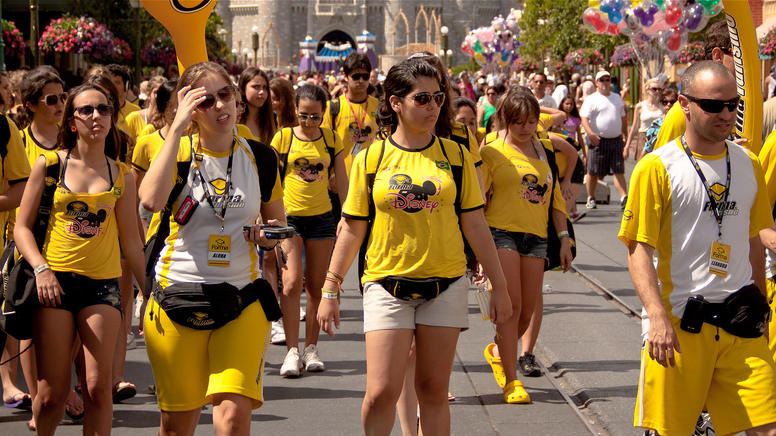A daily part of tourism in ANY tourist area is tour groups. Whether the groups are from another state, another country or the church in the next town over, they arrive by the busload and give lots of money to the hotel and restaurant industries and, in the case of Central Florida, the theme park industry.
Although tour groups come to Orlando from a lot of places (Argentina, Peru, Paraguay, Uruguay, Asian countries, etc), the group that tends to gather the most reactions are the ones from Brazil. Those groups tend to be kids (girls more often than boys) in their mid-teens, they travel in groups of 25 or more and tend to have the same shirts, knapsacks, etc. They speak Portuguese, which sounds a bit like a cross between Spanish and Italian, but is not exactly the same.
A lot of the groups are girls celebrating their quinceañera, the Latinx coming-of-age-at-15 party; it’s the equivalent of a sweet 16 in the U.S. or a bar/bat mitzvah for Jewish kids. Years ago the all-important birthday was celebrated with a big party at home. But in the past couple of decades, trips to Walt Disney World have become all the rage for these young ladies who are turning “the big one-five,” and some families spend years saving for their girls to go on this once-in-a-lifetime trip.
These groups are huge, with tour groups bringing a few hundred to a thousand or more girls to Central Florida at one time. Fortunately, the groups are broken into smaller sub-groups of a few dozen, and each sub-group usually has at least one tour guide with them who carries a flag so their charges can see and recognize them.
Brazilians are generally optimistic, happy and fun-loving people but some of the social and cultural norms of Brazilians are different from those of other countries such as the U.S., and the resulting behavior of these 15-year-old girls can sometimes make non-Brazilians bristle while in a theme park:
- Chanting in a group to pass the time
- Singing in a group because it’s fun
- Personal space is not super important (so they may put their hand on your shoulder or back as they pass by you)
These are on top of what happens when there is a “group” mentality, not a whole lot of adult supervision at any given time (one or two adults in his/her early-mid 20s supervising maybe 25-35 15y/o kids?), and, let’s face it, the self-centered mentality of a bunch of girls who are 15 years old ;-). So the resulting issues wind up being:
- Singing in the queues
- Chanting on the rides
- A group of 5 kids wanting to be with their friends, so the 5 kids in front of you in the queue, or sitting next to you at the parade are now 50 kids in front of or surrounding you.
These situations can sometimes be, I know from my own experience, a little (or sometimes more than a little) frustrating. And it’s worsened because many of the kids don’t appear to speak English so most of us can’t really communicate with them. But to be honest, many the same kind of behaviors and “group mentality” are seen when groups of teenage American cheerleaders or dancers, school trip kids or even church trip kids are in the parks with what may or may not be enough adult supervision.
So What Can You Do About Them?
At Walt Disney World, at least, the groups from Latin America are supposed to have a Cast Member from Disney’s Cultural Representative Program on hand. These bilingual Disney representatives have responsibilities that may include:
- Proactively seeking out guest contact
- Acting as a translator for leaders and cast
- Being able to work under pressure and overcoming guest objections
- Assisting with audience control including parades
I’ve seen these representatives at work at parades, restaurants, etc. and they do help diffuse potential problems before they happen. But they’re a little less effective when you’re queued for the Haunted Mansion, you’ve got 25 kids in front of you, 25 kids who are 10 people behind you, they’re trying to get together into one big group, and they’re all chanting as they enter the stretching room. So I’m well aware that sometimes you feel like you need to take matters into your own hands.
The most important thing to remember is your ability to “fix” the situation will be limited. It would be nice if these groups, usually comprised of kids, would act like what we would consider being responsible adults, but reality is that they’re not adults, their level of responsibility reflects that, and their social/cultural norms may not be the same as ours (which, quite honestly, isn’t right or wrong – it just “is”). So frankly, the thought that “it is what it is” is probably a good thing to keep in your head.
If the behavior of these larger groups of kids bothers you that much, my first suggestion is to try to avoid them as much as you can:
- Brazilian schools are out of session in the summer and in January, cheer and dance competitions have their own schedules and U.S. schools tend to have their trips at the end of the school year. You might not want to visit Central FL during those times, if possible.
- Tour groups tend to stay at the less expensive Disney-owned hotels. Moderate-or-above level Disney resort hotels or staying off property might be alternate options.
- If you see a tour group heading into an attraction or restaurant, go to a different one.
- Plan to eat at “off” times, when there are fewer crowds and, most likely, fewer tour groups trying to eat at the same time.
If there’s a group of kids all wearing the same shirt/knapsack/etc. in front of you in a queue and a group behind you and they want to all stand in line together in the front group, hold your ground if their trying to get in front of you bothers you that much. Tell them no. Tell them that the group in front can go back to be with their friends, if they want – and if they don’t appear to speak English, pointing and hand gestures can work just as well as talking. So does making a barrier of your party and perhaps the parties around you (if they’re of the same mindset).
Telling their group leader or Disney’s Cultural Representative, if possible, may have some effectiveness. If you can’t locate him/her/them, telling the cast member/team member/employee who works at the attraction/restaurant/etc. about the problem may be able to help to a point, but I would think their hands are tied to an extent – their job is to keep everybody happy, not just you.
The bottom line is these tour groups have as much right to be there as we do and as much as we might like to see them change their behavior, the only peoples’ behaviors we can really change is our own. Whether that means visiting at a different time or opening your heart to an “it is what it is and I’ll just make the best of it” point of view, it’s up to us to ensure these tour groups don’t ruin our vacation.
Like this post? Please share it! We have plenty more just like it and would love if you decided to hang around and clicked the button on the top (if you’re on your computer) or the bottom (if you’re on your phone/tablet) of this page to follow our blog and get emailed notifications of when we post (it’s usually just two or three times a day). Or maybe you’d like to join our Facebook group, where we talk and ask questions about travel (including Disney parks), creative ways to earn frequent flyer miles and hotel points, how to save money on or for your trips, get access to travel articles you may not see otherwise, etc. Whether you’ve read our posts before or this is the first time you’re stopping by, we’re really glad you’re here and hope you come back to visit again!
This post first appeared on Your Mileage May Vary
Join our mailing list to receive the latest news and updates from our team.

